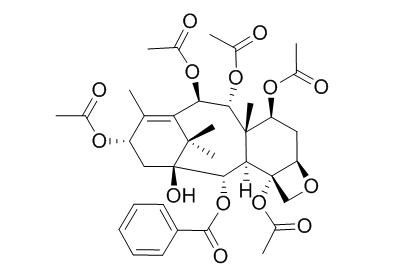Baccatin VI
Baccatin VI possesses significant antinociceptive activity against p-benzoquinone-induced abdominal contractions.
Inquire / Order:
manager@chemfaces.com
Technical Inquiries:
service@chemfaces.com
Tel:
+86-27-84237783
Fax:
+86-27-84254680
Address:
1 Building, No. 83, CheCheng Rd., Wuhan Economic and Technological Development Zone, Wuhan, Hubei 430056, PRC
Providing storage is as stated on the product vial and the vial is kept tightly sealed, the product can be stored for up to
24 months(2-8C).
Wherever possible, you should prepare and use solutions on the same day. However, if you need to make up stock solutions in advance, we recommend that you store the solution as aliquots in tightly sealed vials at -20C. Generally, these will be useable for up to two weeks. Before use, and prior to opening the vial we recommend that you allow your product to equilibrate to room temperature for at least 1 hour.
Need more advice on solubility, usage and handling? Please email to: service@chemfaces.com
The packaging of the product may have turned upside down during transportation, resulting in the natural compounds adhering to the neck or cap of the vial. take the vial out of its packaging and gently shake to let the compounds fall to the bottom of the vial. for liquid products, centrifuge at 200-500 RPM to gather the liquid at the bottom of the vial. try to avoid loss or contamination during handling.
Biomed Pharmacother.2023, 162:114617.
Allergol Immunopathol (Madr).2022, 1;50(4):23-30.
Biomedicines.2020, 8(11):486.
Biomol Ther (Seoul).2019, 10.4062
Nat Prod Commun.2014, 9(5):679-82
Oncotarget.2017, 8(53):90925-90947
Journal of Functional Foods2019, 52:430-441
BMC Complement Med Ther. 2020, 20(1):91.
Antioxidants (Basel).2022, 11(12):2411.
Toxins (Basel).2022, 14(12):824.
Related and Featured Products
J Asian Nat Prod Res. 2006 Apr-May;8(3):229-39.
The dynamic variation of several important taxane content in post-harvest Taxus chinensis clippings.[Pubmed:
16864429 ]
The dynamic variations of several important taxanes, taxol, baccatin III (B-III), 1-acety-5,7,10-deacetyl-baccatin I (DAB-I) and Baccatin VI (B-VI), were investigated in post-harvest clippings of Taxus chinensis.
METHODS AND RESULTS:
The clippings were preserved over 20 days at two different temperatures (4 degrees C and room temperature), or by cuttage in the light and in the dark, or promptly dried. The accumulation of taxol in needles of the clippings was found increase in the initial stages of the stored period and then decreased gradually. The maximum accumulation of taxol occurred in the case of cold storing (4 degrees C) at day 3, doubling the data on the day when the biomass was harvested. In contrast, in the cases of cold storage and cuttage the contents of the other three taxanes showed a sharp decrease at the beginning and then an increase from 3 to 6 days, and subsequently a drop until day 20. The similar variation of taxane contents was not found in the needles of immediately dried clippings as well as in the stem samples of clippings.
CONCLUSIONS:
These results indicated that the content variation of taxol and related taxanes of post-harvest clippings was related to the manner of preservation, timing and plant tissue. Moreover, the mechanism of the fluctuation of the taxane contents in post-harvest clippings is discussed, in particular taxol biosynthesis in response to mechanical wounding of harvest.
J Ethnopharmacol. 2003 Dec;89(2-3):265-70.
Anti-inflammatory and antinociceptive activity of taxoids and lignans from the heartwood of Taxus baccata L.[Pubmed:
14611890]
METHODS AND RESULTS:
Four taxoids (taxusin, Baccatin VI, baccatin III and 1beta-hydroxybaccatin I) and five lignans (lariciresinol, taxiresinol, 3'-demethylisolariciresinol-9'-hydroxyisopropylether, isolariciresinol and 3-demethylisolariciresinol) were isolated from the heartwood of Taxus baccata L. (Taxaceae) growing in Turkey through chromatographic techniques. In vivo anti-inflammatory and antinociceptive activity of these compounds were investigated.
CONCLUSIONS:
All the compounds were shown to possess significant antinociceptive activity against p-benzoquinone-induced abdominal contractions, while only lignan derivatives significantly inhibited carrageenan-induced hind paw edema in mice.



